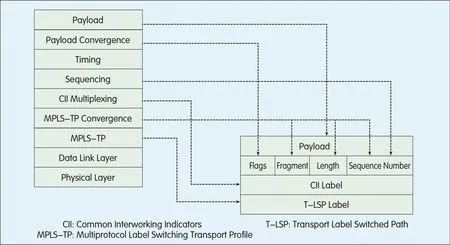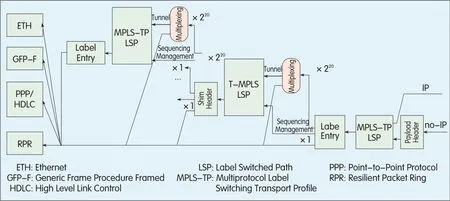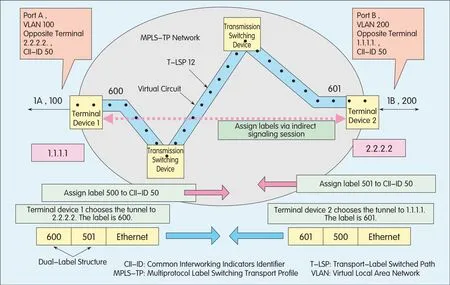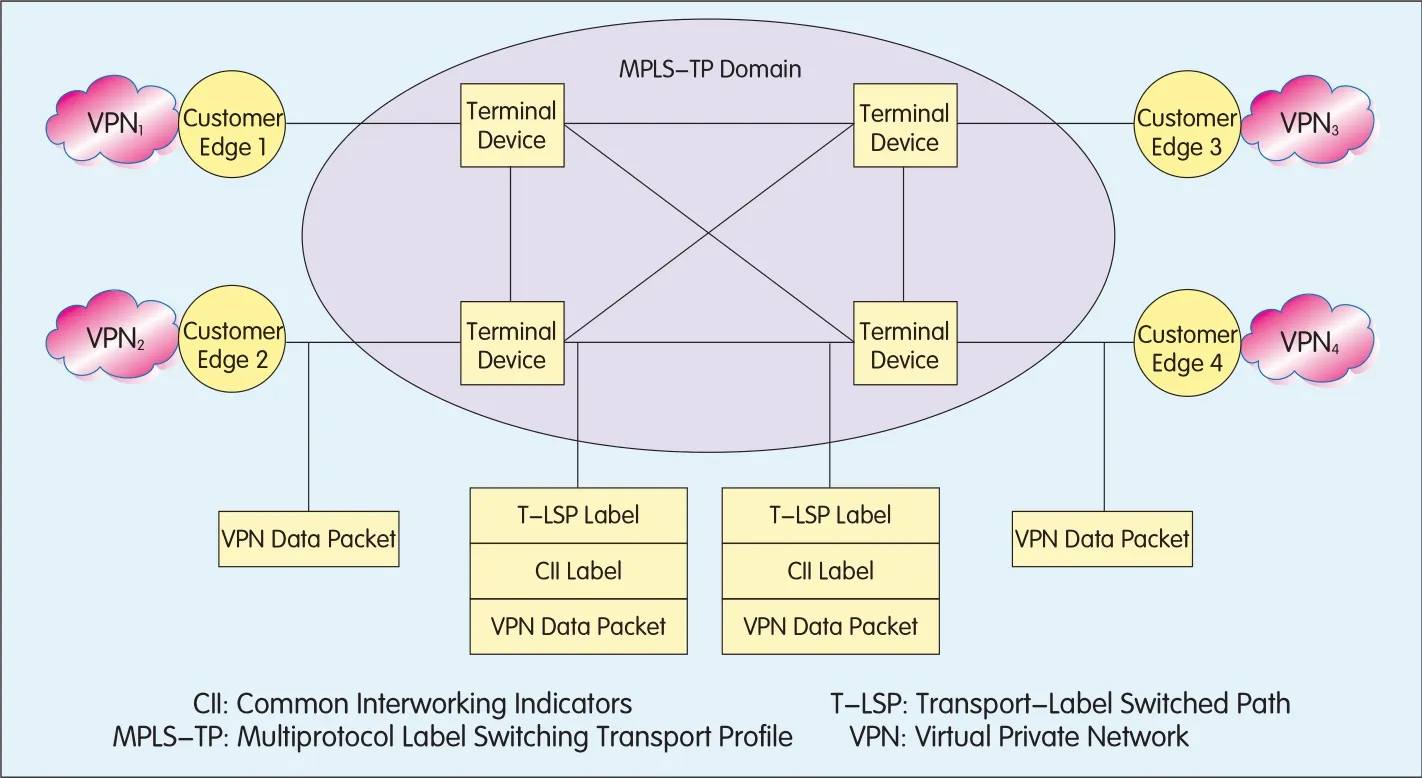Service Adaptation and Label Forwarding Mechanism for MPLS-TP
2010-06-05ZhangYongjunZhangZhihuiGuWanyi
Zhang Yongjun,Zhang Zhihui,Gu Wanyi
(Key Laboratory of Information Photonics and Optical Communications of Ministry of Education,Beijing University of Posts and Telecommunications,Beijing 100876,P.R.China)
Abstract:Most services borne by transport networks have been transitioned away from Time Division Multiplexing(TDM)towards IP-based.New technology is therefore required to effectively transport packet services.Multiprotocol Label Switching Transport Profile(MPLS-TP)is such a technology which is connection-oriented,capable of multiservice adaptation,and has a flexible label forwarding mechanism.This paper analyzes the characteristics of MPLS-TP,and introduces its latest standardization development.Key issues including data forwarding plane,service adaptation,and label forwarding mechanism are discussed,as well as service implementation of Virtual Private Network(VPN)based on dual-label transport.MPLS-TPapplications are summarized in conclusion.
This work was funded by the National High Technology Research and Development Program of China(“863”Program)under Grant No.2008AA01A328.
S ervice networks are undergoing transformation due to the shrinkage of traditional telecom services and the trend towards IP-based services.The future market will require packet transport technology that transmits packet services effectively,but also provides carrier-class Operation,Administration and Maintenance(OAM),as wellas protection.Transport devices must change from being adaptable to multiservice interfaces into being adaptable to multiservice kernel.In other words,IP-based services require packet transport networks;but at the same time,traditional services such as voice should be delivered normally.To achieve this,packet technologies and transport technologies must be integrated.And in this context,Packet Transport Network(PTN)is introduced[1].
There are 2 solutions available for PTNimplementation:enhanced Ethernet technologies,and transport technology combined with Multiprotocol Label Switching(MPLS).Provider Backbone Bridge Traffic Engineering(PBB-TE)—or Provider Backbone Transport(PBT)—is representative of the former;MPLS Transport Profile(MPLS-TP)—or Transport MPLS(T-MPLS)—is representative of the latter.Compared with other technologies,these better serve the goals of PTN,and have come into mainstream use.Both are connection-oriented,have performance and reliability similar to Synchronous Digital Hierarchy(SDH),and offer standard,connection-oriented tunnels.Their main differences lie in the way they implement data forwarding,protection and OAM.In the process of standardization,T-MPLShas outpaced PBT.T-MPLSstandards have matured,and meet requirements for commercialization,although there is still room for improvement.
1 MPLS-TP Features and Standardization
1.1 MPLS-TP Standardization
Since 2005,Study Group 15 of the International Telecommunication Union Telecommunication Standardization Sector(ITU-TSG15)has focused on using MPLStechnology to define packet transport layer’s service function structure(T-MPLS technology).In 2007,ITU-Tmade recommendations on aspects such as system framework,interface and device specifications,OAM,protection switching mechanism,and service signal adaptation.These recommendations have received support from the Internet Engineering Task Force(IETF).At present,ITU-Tis working on detailed definitions of all layer functions,addition of adaptive client signals,and service interconnection and synchronization.IETFis preparing T-MPLSRequest for Comments(RFC),and defining new labels for T-MPLSservices.In 2008,ITU-Tand IETFestablished a Joint Work Team(JWT)to promote the merging of T-MPLSand MPLS.IETF expanded existing MPLStechnology into MPLS-TPto better support transport requirements specified by ITU-T.In the future,JWTwilldevelop MPLS-TPstandards and ensure consistency between T-MPLSand MPLS-TPstandards[2].
1.2 MPLS-TP Technical Features
MPLS-TPhas a clear framework and complete solutions for implementing its key techniques.It simplifies and innovates on MPLS/Pseudo Wire(PW)technology,introducing concepts such as PTN layer,OAM and linear protection.Thus,it meets the demands of PTN[3].As a connection-oriented packet transport technology,MPLS-TP consists of a data plane,management plane,and control plane.An end-to-end connection-oriented packet transport tunnel is also established.This tunnel,set up with the network management system or intelligent control plane,is characterized by good operability,and maintenance and protection recovery.MPLS-TPmaps client signals into MPLSframes and forwards them using mechanisms such as label switching or label stack.Basic functions of the transport layer—including connection and performance monitoring,survivability and management and controlplanes—are included[4-5].
MPLS-TPadopts a dual-label transport mode[6].When it provides packet data transport for the client layer,it assigns 2 labels to client data:Common Interworking Indicators(CII)and Transport Label Switched Path(T-LSP).The CIIlabel associates the clients at both ends,and is used by terminals to distinguish client data,while T-LSPlabel is used for exchange and forwarding client data in the MPLS-TPpacket data tunnel.
In short,MPLS-TPis a subset and abbreviated version of MPLS.To support a connection-oriented end-to-end OAM model,many connectionless features are excluded but protection switching and OAM functions recommended by the ITU-T are present.Allthese facilitate carrier-class services.MPLS-TPalso retains MPLSfeatures that are helpful for data service transport,discards the complicated MPLScontrol protocol cluster defined by IETF,simplifies the data plane,and removes unnecessary forwarding processing.As a result,it is suited to situations where TDM-based services are being transitioned into IP-based ones.
2 MPLS-TP Service Adaptation Technologies
The unified transport/aggregation platform is a breakthrough in service networking technologies.Service providers need not invest in each network layer to transport mixed services.In MPLS-TP,the transport plane is responsible for packet transport of client data,and also adapting to and forwarding client signals.For different client signals,different signal adaptation and forwarding methods are employed.packet data,cell data and TDM data are quite different in length,format,and multiplexing mode.Therefore,different aggregation,fragmentation,encapsulation,sequencing,timing and multiplexing/demultiplexing methods are used in their adaptive transport[7].
2.1 Signal Adaptation
Client signals can be directly mapped into T-LSP,or indirectly mapped based on CII.In the dual-label architecture,all types of service signals can be encapsulated in a dual-labelstructure.The encapsulation layer structures the specified payload signals for transmission over the Virtual Circuit(VC).It consists of 3 sub-layers:payload convergence,timing,and sequencing.The payload convergence sub-layer is tailored to the specific payload type.It can group a number of payload types into a generic class,and then provide a single convergence sub-layer type that is common to the group.The timing and sequencing sub-layers provide generic services to the payload convergence sub-layer.The functions of the 3 sub-layers are described below.
(1)The payload convergence sub-layer is primarily responsible for encapsulating the payload in VC Protocol Data Units(VC-PDUs).It carries the additional information needed to replay the native data units at the Customer Edge(CE)boundary.When a bitstream is sent to MPLS-TP,one part is peeled off the native service processing module.For example,in structured SDH,fragmentation and circuit overheads may be peeled off.
(2)The sequencing sub-layer performs three functions:frame ordering,frame duplication detection,and frame loss detection.Some services must be delivered in order,while other services need not.The choice of strategy for handling incorrect frame sequence,or detected frame duplication or loss depends on the service type.Client signals such as SDH and Frame Relay(FR)may have clock recovery and timed packet delivery timing requirements.
(3)The timing sub-layer performs two functions:clock recovery and timed delivery.Clock recovery involves extracting clock information from the delivered bit stream,and recovering the clock with a phase-locked mechanism.Timed delivery involves delivering non-contiguous VC-PDUs to CEs with a constant phase relation.
IPservices can be directly mapped into T-LSPor indirectly mapped by means of dual labels.In dual-label encapsulation,a node does not need L3 forwarding capability.Hence,in networks where nodes do not have L3 forwarding capability,dual-label encapsulation is advantageous.With non-IPservice adaptation,VC-based indirect mapping is adopted.As multiple VC multiplexing is transferred in a Label Switched Path(LSP),the service granularity can be less than 2 Mbit/s.Moreover,with CIIand label stack added into the services,address space limitation—which occurs in some technologies—can be overcome.
2.2 Service Encapsulation
The generic encapsulation format of services is illustrated in Figure 1.The payload containing L2 header or L1 overhead can be IPpacket,Ethernet packet,ATM cell,FRcell,or SDH payload.Data information and control words are used for payload convergence.With CIIlabel built in,the VC type in T-LSPcan be determined;with T-LSPlabelbuilt in,MPLS-TPLSP can be determined.Control words often include flags,fragment,length,and sequence number.At the destination end—after terminating the LSPand withdrawing the outer T-LSPlabel—the device decides which high-layer service instance the data stream belongs to.This is based on the inner CIIlabel.
The transport plane of MPLS-TPhas an additional feature:It is transparent to the client layer and service layer.Transparency to the client layer means that any client signal can be carried on MPLS-TPnetwork and transmitted in the form of packets.The client network can be IP,Ethernet,ATM,FR,PDH,or SDH.Transparency to the service layer means that MPLS-TPcan use any underlying technology for transport.Before MPLS-TPhas its own data link layer protocol,packets can be carried and transmitted via existing Ethernet or SDH networks.
3 Label Forwarding Mechanism
MPLS-TPadopts the dual-label transport mode in which L3 IPis used to transmit L2 Ethernet data.The 2 labels are CIIand T-LSP.To support MPLS-TPnetworking,T-LSPlabels can be infinitely embedded.Therefore,there may be several T-LSPlabels.The CIIlabel can be a client signal label;for example,in Figure 2,the CIIlabel refers to VC labels.The multiplexing/demultiplexing module binds several VCs into a VC Group(VCG)and transfers it on the same T-LSP.In this way,the complexity of the transport and switching devices of the network is reduced and less bandwidth is consumed.
3.1 Packet Switching and Forwarding
The service packet switching and forwarding functions of MPLS-TPare mainly involved in exchanging MPLS-TPlabels of the packet client data and forwarding the data.Specifically,the functionalmodules include pre-processing,forwarding and switching,encapsulation,fragmentation,sequencing,timing,multiplexing/demultiplexing,and monitoring.
(1)Pre-processing refers to the operations on client data before switching.These operations include data and address conversion,and identification of client data type.Pre-processing simplifies the design of the processing steps that follow.(2)The convergence module is mainly responsible for sorting and converging packets based on type,and importance of client data signals or signaling signals.It dispatches packets to different transport channels,so that different signal types receive different classes of Quality of Service(QoS).
(3)The encapsulation module adapts the signals before they are multiplexed with T-LSPand forwarded.The workings of the module are closely related to the client signal type to be encapsulated.For example,different encapsulation methods are used for packets,cells,and Time Division(TD)signals.Encapsulation is the process of attaching VC and T-LSPlabels onto the packets,and inserting OAM information into the packets.Depending on the client signal type,3 sub-modules may be used:fragmentation,sequencing,and timing.If a client signal exceeds the maximum packet length that can be carried by a service layer network,it must be fragmented.Some clients require sequenced delivery and real-time support,so their signals should be delivered in a sequenced and timed way.A sequencing function provides three services:frame ordering,frame duplication detection,and frame loss detection.SDH and FR client signals may require timed clock recovery and timed packet delivery.
In an MPLS-TPnetwork,the mapping from client signals onto link frames involves client service encapsulation,signalmultiplexing,and mapping of MPLS-TPpackets into link frames.Figure 3 illustrates the relationship between information units in an MPLS-TPnetwork.

▲Figure 2.An example of MPLS-TPdual-labelstructure.

▲Figure 1.Generic encapsulation format of services.

▲Figure 3.MPLS-TPmapping,multiplexing and fragment detection.
Client signals can also include OAM packets of T-MPLSnetworks.Both the data packet and the OAM packets may have a label header for multiplexing.Finally,MPLS-TPpackets are mapped onto data link frames,which are transmitted via MPLS-TPtopological links.The forwarding and switching module on MPLS-TPterminal devices is responsible for switching the processed client data to related T-LSP and forwarding them.Intermediate transport switching devices continue to forward the packet data with MPLS-TP labels until the data is demultiplexed by the terminaldevice at the destination.The destination terminal devices forward the data to destination CEs[8-9].
3.2 Signaling Transfer with Dual-Label Transport Mode
To explain signaling transfer in dual-label transport mode,an example will be provided.Suppose there are 2 Ethernet Virtual Local Area Networks(VLANs):Ethernet VLAN 1(port 1A,VLAN 100)and Ethernet VLAN 2(port 1B,VLAN 200).An MPLS-TPVCis established between them based on Label Distribution Protocol(LDP).Figure 4 illustrates a solution for signaling transfer between the 2 Ethernet VLANs.
The process of establishing MPLS-TPVCand transferring signals is described below.
Ethernet VLAN 1 makes a request to Terminal Device 1 of MPLS-TPnetwork to establish an MPLS-TPVC to Ethernet VLAN 2.
Terminal Devices 1 and 2 of MPLS-TPnetwork negotiate and assign a VC Identifier(VCID)to the VC.
Terminal Device 1 initializes a LDP signaling session to Terminal Device 2 if one is not already present.Once the two terminal devices receive a LDP KEEPALIVEmessage from each other,they set up the session and are ready to switch the labels bound on the VC.
After the Ethernet VLAN’s state becomes“UP”,Terminal Device 1 assigns a local CIIlabel(500 in this example)for the VC based on its VCID.It sets up T-LSP 1 for transport over the VC,assigning the VC a T-LSPlabel(600 in this example).
Terminal Device 1 converts the T-LSPlabel into T-LSPtunnel Type-Length-Value(TLV).the local CIIlabel into LABELTLV,and the CII Identifier(CII-ID)into Forwarding Equivalence Class(FEC)TLV.It then sends a LABELMAPPING message to Terminal Device 2.
Terminal Device 1 receives a LABEL MAPPING message from Terminal Device 2 and decodes the message to obtain CIIlabel and CII-ID.
At the same time,Terminal Device 2 runs the same steps(1)to(6)independently.After the two terminal devices have finished label binding,exchanging their labels,and confirming their port parameters are correct,T-MPLSVC with CII-ID 50 is successfully set up.If one Ethernet LAN connection fails to work or is removed,a label cancel message will be sent to the opposite terminal device to cancel the assigned MPLS-TPCIIlabel.
3.3 Dual-Label Transport Mode-based VPN Services

▲Figure 4.Establishment of MPLS-TPVCbased on LDP.
MPLS-TPnetworks have rich OAM overhead functions[10]to monitor and manage signals in the network.This improves the operability and security of the entire network,and paves the way for Virtual Private Network(VPN)services in the MPLS-TPnetwork.Traditional VPN technologies(L2 or L3 tunneling technologies)are easy to implement,but are defective in scalability,security,management and maintenance,QoS,and traffic engineering.In particular,when a client adopts multiple access technologies such as Point-to-Point Protocol(PPP),ATM,FR,and Ethernet,the operator must configure several core networks accordingly in order to offer VPN services.VPN services based on MPLS-TPtechnology can be implemented in a unified network platform that is independent of transport technologies.

▲Figure 5.Implementation of MPLS-TPVPN.
MPLS-TPVPN is more easily achieved with point-to-point tunnels set up in the MPLS-TPbackbone network.Its CEs do not participate in L3 routing,and the client itself configures routing within the VPN.This makes MPLS-TPVPN independent of the client’s L3 network protocol.In MPLS-TPVPN,terminal devices are only responsible for L2 connection,and forwarding between CEs.Functions of L3 or above are performed by CEs.The MPLS-TPnetwork itself can carry different client signals.By means of signaladaptation and encapsulation,a client can use different technologies to access the MPLS-TPVPN,thus satisfying the client’s demand for low cost interconnection of VPNs of different layers.
Figure 5 illustrates MPLS-TPVPN.It can been seen that dual labels are adopted,where a T-LSPlabelidentifies the shared tunnel between terminal devices,and a CIIlabelidentifies the dedicated connection between CEs.The CIIlabel,in the form of a MPLS-TP label stack,is multiplexed in the LSP-based tunnel of the MPLS-TP backbone network.The LSPcan be regarded as a tunnelcarrying several VCs,and a VC is equivalent to a point-to-point route established by the LDPfor VPN users.
4 Conclusion
With good service adaptation and label forwarding capabilities,MPLS-TP technology is well-suited for packet transfer.However,it is rivaled by other packet transport technologies such as PBT.As an emerging technology,MPLS-TPneeds the joint efforts of standardization organizations,telecom operators,and equipment vendors to hasten its maturity.
杂志排行
ZTE Communications的其它文章
- Standardization Progress of Packet Transport Networks
- Several Issues in the Development of Packet Transport Networks
- Features of PBB-TEArchitecture and GMPLSControl Technology
- Ring Protection and Survivability Mechanisms for Packet Transport Networks
- PTN Clock Synchronization Technology and Its Applications
- PTN and IP-Based Mobile Backhaul
